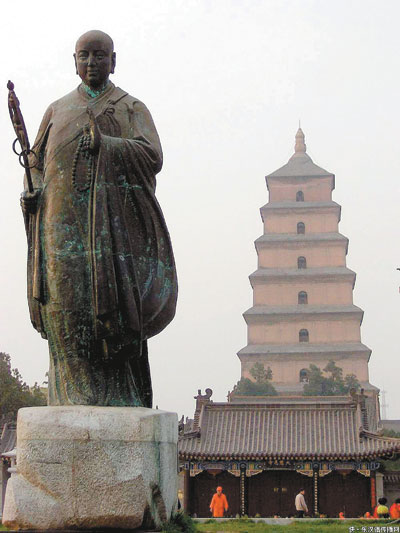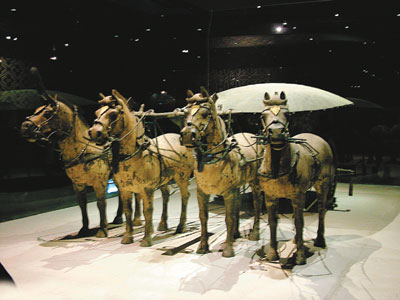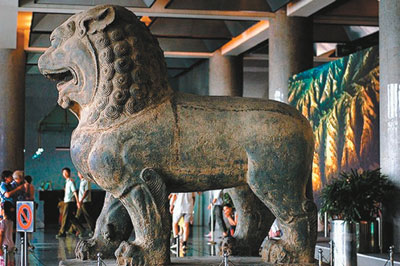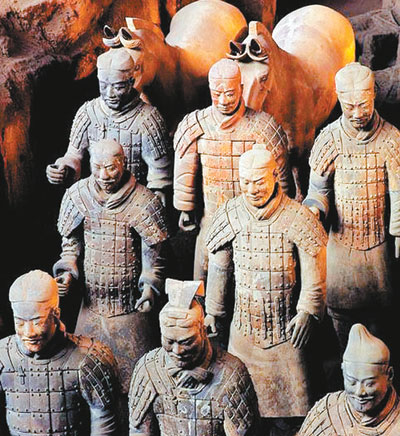
Wang Yuanyuan cheekywang@hotmail.com LOCATED in the northwest of China, Xi’an, capital of Shaanxi Province, is one of the oldest cities in China with more than 3,100 years of history. The capital of the Eastern Zhou (770-256 B.C.), Qin (221-206 B.C.), Han (206 B.C.-A.D. 220), Sui (581-618) and Tang (618-907) dynasties, the city is also the eastern terminus of the Silk Road and home to the terra-cotta warriors and horses.  Covering an area of 9,983 square meters, Xi’an has many other historical relics and much attractive natural scenery. The city government makes sure that Xi’an’s most popular attractions are easy to get to so the local tourism industry continues to thrive. Terra-cotta army The terra-cotta army is unquestionably the most famous historical site in Xi’an and is known as “the eighth wonder of the world.”  Located about 38 kilometers from downtown Xi’an, the terra-cotta army is a collection of terra-cotta sculptures depicting the armies of Qin Shihuang, the first emperor of China. It is a form of funerary art buried with the emperor, aimed at protecting him in the afterlife. The figures, dating from the 3rd century B.C., were discovered in 1974 by farmers in Lintong District. The army includes soldiers, chariots and horses. Current estimates suggest that the terra-cotta army originally consisted of over 8,000 soldiers, 130 chariots with 520 horses and 150 cavalry horses, the majority of which are still buried in the pits near Qin Shihuang’s mausoleum. Other non-military figures were also found in the pits such as officials, acrobats, strongmen and musicians, but that area has not yet opened to the public. The mausoleum is about 1.5 kilometers away from the army under Lishan Mountain and technology has not yet developed to the stage which would allow archaeologists to dig there safely. Transport: Take bus No. 5 at Xi’an Rail Station to the site. The taxi fare from downtown Xi’an to the site is about 80 yuan. Shaanxi History Museum Located in downtown Xi’an, the Shaanxi History Museum is the city’s best place to learn about Chinese history, culture and art. Opening in 1983, it is one of China’s oldest and best history museums.  A Tang Dynasty-style building, it houses a collection of 370,000 items including murals, paintings, pottery, coins, as well as bronze, gold, and silver objects. All items, dating from ancient times to the Qing Dynasty (1644-1911), were discovered in Shaanxi Province. The most popular items include fossils of Lantian Man (which is older than Peking Man), the deer pattern eaves tile from the Qin Dynasty, the kneeling archer — a 120-centimeter-tall figure found in Emperor Qinshihuang’s tomb, the four-footed Li — a Shang Dynasty (1600-1100 B.C.) bronze cooking utensil, a Tang Dynasty mural of people playing polo in ancient China and the empress’ seal — a jade seal from the Han Dynasty (206 B.C.-A.D. 220). Buses: 519, 24, 26, 27, 30, 34, 401, 521, 527, 610, 701, 710 Giant Wild Goose Pagoda The Giant Wild Goose Pagoda, located in downtown Xi’an, is a Buddhist pagoda built in 652 during the Tang Dynasty and is now the city’s only surviving Tang building. It originally had five stories and its brick facade was renovated during the Ming Dynasty (1368-1644). One of the pagoda’s many functions was to hold sutras and figurines of the Buddha that were brought to China from India by the Buddhist translators and traveling monk Xuanzang. Asia’s largest music fountain performance will be staged in front of the pagoda every night. Its front square with beautiful plants and colorful lights is also a nice place to experience a quiet Xi’an night. Buses: 6, 21, 22, 24, 601, 610 | 
